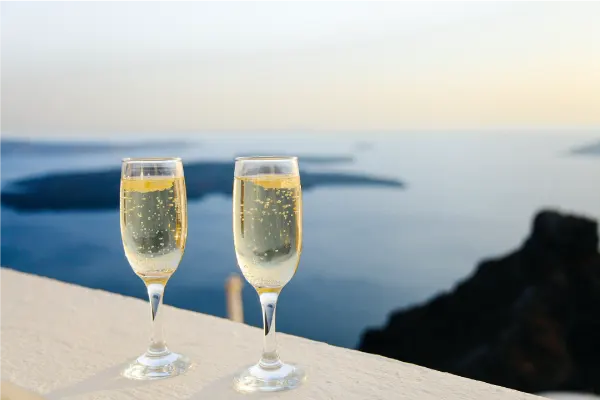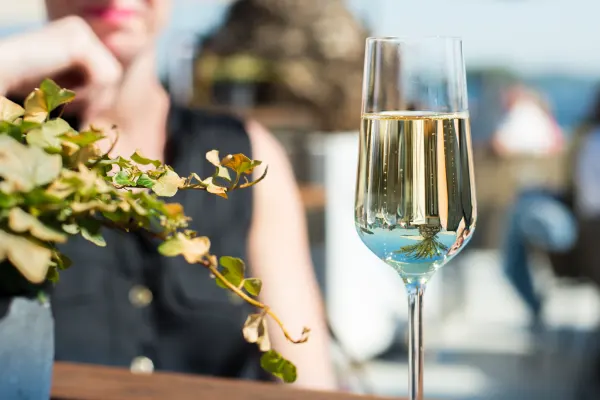Sparkling wine is characterized by the production of persistent bubbles the moment we open the bottle. It is a wine that is usually associated with refinement and moments of celebration and is usually presented in white or rosé, but there is also sparkling reds.
The History of Sparkling Wine
The history of Sparkling Wine began in France, in the 17th century, in a region called Champagne. At that time, wines were sold in vats and their main characteristic was that they were effervescent, which turned out to be a problem for conservation and transportation. With the invention of bottles in 1680, the big problem came for Champagne wines, since they underwent a second fermentation when they were placed in the bottle, which caused them to explode.

Don Pérignon, a Benedictine monk, was responsible for the wines and aimed to solve this problem. When studying, he realized that because of the carbon dioxide the bottles exploded, so he suggested that they be reinforced. It was Dom Pérignon who was most dedicated to the process of the second fermentation in the bottle, which today is known as Champenoise.
Sparkling Wine Characteristics
The best way to distinguish the types of sparkling wine is through the type of fermentation. There are three types: Asti, Charmat and Champenoise.
- Asti – The gas in this type of wine is a direct result of the fermentation of the grapes. They are usually simpler, fresher and more aromatic wines.
Examples: Italian Astis and sparkling Muscats. - Charmat – Unlike Asti, the base product is already fermented wine. The wine is placed in fermentation tanks, a solution with yeast and nutrients is added and a new fermentation is carried out. The result is a more complex sparkling wine with more structure than the previous one.
Examples: Italian proseccos and sparkling wines from Brazil. - Champenoise – It is the method used to make Champagne. It is important to know that Sparkling Wine is only considered Champagne if it is produced using this method and produced in the French region of Champagne. The start of the process is the same as Charmat, the difference is in the second fermentation, because in Charmat the fermentation is done in tanks, in Champenoise it happens in the bottle.
Examples: Champagnes, Cava and Franciacorta, some sparkling wines from the Douro and Brazil.
Durability of Sparkling Wine before opening
- NV, White, Rosé, plain Prosecco Cava: 1 to 3 years
- Champagne NV, vintage Cava: 3 to 6 years
- Vintage Champagne: 6 to 15 years
Most used grape varieties in Sparkling Wine
Like other types of wines, Sparkling Wine can be made using several grape varieties, but each appellation of origin limits the varieties allowed in their area.
- Champagne – Pinot Noir, Meunier and Chardonnay.
- Sparkling from Vale dos Vinhedos – Internationally recognized, Brazilian sparkling wine usually made from Chardonnay and Pinot Noir grape varieties.
- Cava – Macabeo, Xarel-lo, Parellada, Chardonnay, Red Garnacha, Subirat Parent, Pinot Noir, Monastrell and Trepat.
- Prosecco – Glera, minimum 85%. The other 15% can be divided between Verdiso, Bianchetta Trevigiana, Perera, Glera Lunga, Chardonnay, Pinot Bianco, Pinot Grigio and Pinot Nero.
Types of Sparkling Wine according to the degree of sugar
- Brut Nature – less than 3 grams per liter
- Extra Brut – less than 6 grams per liter
- Brut – less than 12 grams per liter
- Extra Dry – between 12 and 17 grams per liter
- Séc – between 17 and 32 grams per liter
- Démi Séc – between 32 and 50 grams per liter
- Doux – more than 50 grams per liter
Ideal temperature for drinking Sparkling Wine
The ideal for sparkling wine is to be drunk very fresh, however it should never be less than 5ºC. The simplest sparkling wines should be served between 6 and 8ºC and the most complex ones between 9 and 12ºC. A more mature Champagne should be served at 10ºC because if it is too fresh, one loses the perception of aromas and flavor.

Harmonization of Sparkling Wine
The Sparkling Wine is an ideal wine to be served as a starter, to accompany aperitifs. They are great to accompany a good “feijoada” since its freshness and acidity take away the flavor of the meat fat.
In Portugal, the Bairrada Wine Region is known for having one of the best sparkling wines, which is traditionally paired with roasted suckling pig, also very famous in this region.
Sweet sparkling wines go well with sweet foods, such as walnut cake, brigadeiro, dulce de leche. However, they also combine with a good board of blue cheeses with gorgonzola and roquefort.
 Portugal
Portugal Spain
Spain France
France Germany
Germany United Kingdom
United Kingdom Monaco
Monaco



